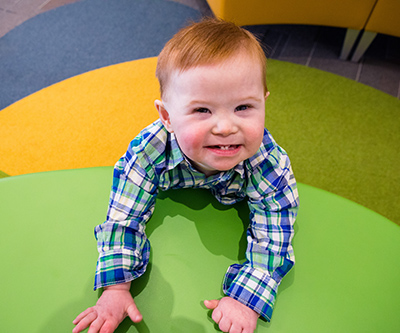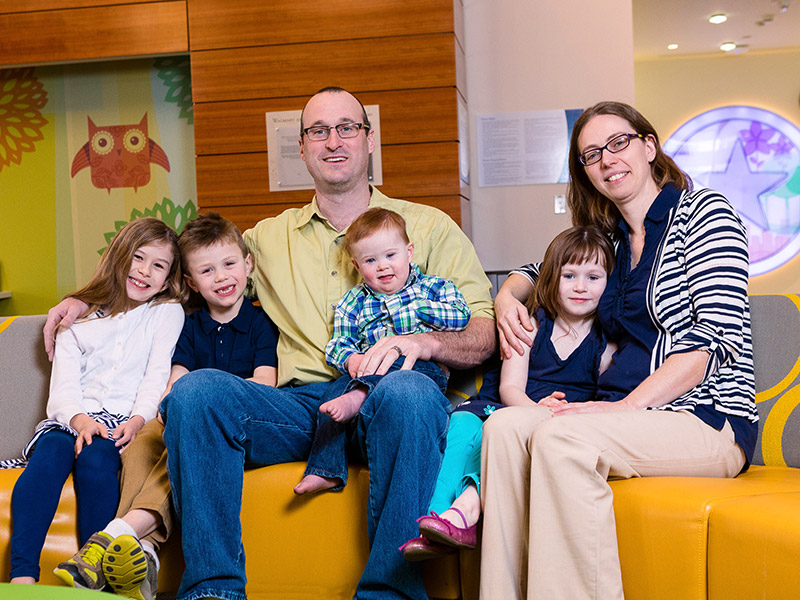Miracle Kid: Ian Galek

Resilient Toddler Beats the Odds
Christa Galek climbed into the ambulance next to her 20-month-old son, still in a haze at how quickly it had all happened.
“Take him to Rochester!” shouted her mother-in-law.
“He won’t make it to Rochester,” replied a paramedic.
The exchange pulled her violently back to reality, as Christa became fully aware of the seriousness of her son’s condition. Quickly, the doors closed, and the ambulance sped off to the hospital.
A Rapid Onset
Ian Galek had been lethargic throughout most of the past day. He wasn’t eating much, and he was napping more often. He’d thrown up the night before. His digestion seemed off.
“He just seemed like a regular sick kid,” said Christa, a resident of Savannah, Wayne County, who had watched Ian’s three older siblings battle a standard variety of childhood ailments as they grew up.

But after putting Ian to bed earlier that evening, she and her husband Seth went in to check on him. His color had changed. He wasn’t responsive; his parents would later learn that he’d gone into shock.
Paramedics took him to Newark-Wayne Community Hospital, where he was stabilized before Mercy Flight brought him to Golisano Children’s Hospital. Once in the pediatric intensive care unit (PICU), doctors and nurses worked to keep him alive. They couldn’t pinpoint what type of infection was causing his drastic decline, so they began treatment with a heavy dose of antibiotics.
But despite their best efforts, Ian’s heart and lungs were failing. He was moved from a standard ventilator to an oscillator, and his condition continued to worsen over the next two days. The last resort was to treat him with extracorporeal membrane oxygenation (ECMO), in which a mechanical device would act as Ian’s heart and lungs while, hopefully, his body worked to repair itself.
“They told us at the beginning that ECMO would be the last thing they could do for him,” said Christa. “But it seemed like we got there really quickly.”

Long Odds
Doctors estimate that those who become sick enough to need ECMO have, at best, a 50 percent chance of survival. But the speed of Ian’s decline, coupled with his Down Syndrome — which can lead to additional health concerns — made his odds even longer.
“Given what he was facing, Ian’s chances were probably worse than fifty-fifty,” said Louis Daugherty, M.D., Associate Professor of Pediatrics and Clinical Care, who treated Ian along with several of his colleagues in the PICU, including Emily Nazarian, M.D., and Heather Reyes, M.D.
Ian’s body swelled up to more than twice its normal size, a consequence of the ECMO treatment. Dialysis drew some of the excess water away, but nowhere near enough to bring him back to his regular size.
“He was a size 4 diaper, but they couldn’t even fit a size 6 on him,” said Christa.
After a week, he developed a skin tear on his arm from the swelling. For any healthy person, the tear would have been negligible.
But blood clots are a major concern for ECMO patients, as they can clog the machinery, so Ian was on a steady dose of blood thinners. This turned a simple cut into a potentially life-threatening emergency.
“Normally, a clot forms and the cut heals itself, but a patient on blood thinners will continue to bleed. Attempting to sew it up could have made it worse,” said Daugherty.
Instead, care providers in the PICU took half-hour shifts applying manual pressure to the cut. Finally, the bleeding stopped.
But the incident underscored the dangers of ECMO treatment, as blood thinners also increase the risk of stroke, among other serious side effects. So after spending 11 days attached to the ECMO machine, Ian’s physicians were getting antsy.
“Every day you’re on ECMO is an additional risk,” said Daugherty. “So as soon as we felt Ian could survive without it, we tried to get him off of it.”

Recovery
It took three tries in all. After each of the first two attempts, Ian’s heart wasn’t strong enough to remain off ECMO for more than a few moments.
But finally, on the third try: success.
“One of the doctors came in and said that he made it through,” said Christa. “We were crying and my husband was out in the hallways shaking everyone’s hands.”
Ian would need continued sedation for six days, but his body kept working to repair itself from the ravages of the infection. His physicians now believe parainfluenza virus triggered a second infection which led to his rapid decline.
“Ian is a strong, resilient kid, and I don’t think enough can be said about his parents, either,” said Daugherty. “We did what we could, the machines did what they could, but his parents’ support was incredible.”
Several months later, Ian would suffer a minor stroke, which was perhaps a consequence of the ECMO treatment. But from this, too, he would recover, and remarkably, he’s shown almost no long-term effects of his ordeal.
Now 2 years old, Ian’s personality and development have returned.
“He has occupational and physical and speech therapists, and they all just say ‘He’s back,’” said Christa. “He’s made it back to where he was before and has started to move past it. It’s incredible.”
“Ian’s sickness was the biggest trial of our lives, and we did a lot of praying,” said Seth Galek. “The miracle of his survival, we feel, was a gift from God, which was embodied in the amazing care we received in Rochester.”
Make a gift to Golisano Children's Hospital and help other kids, like Ian, receive the care they need.